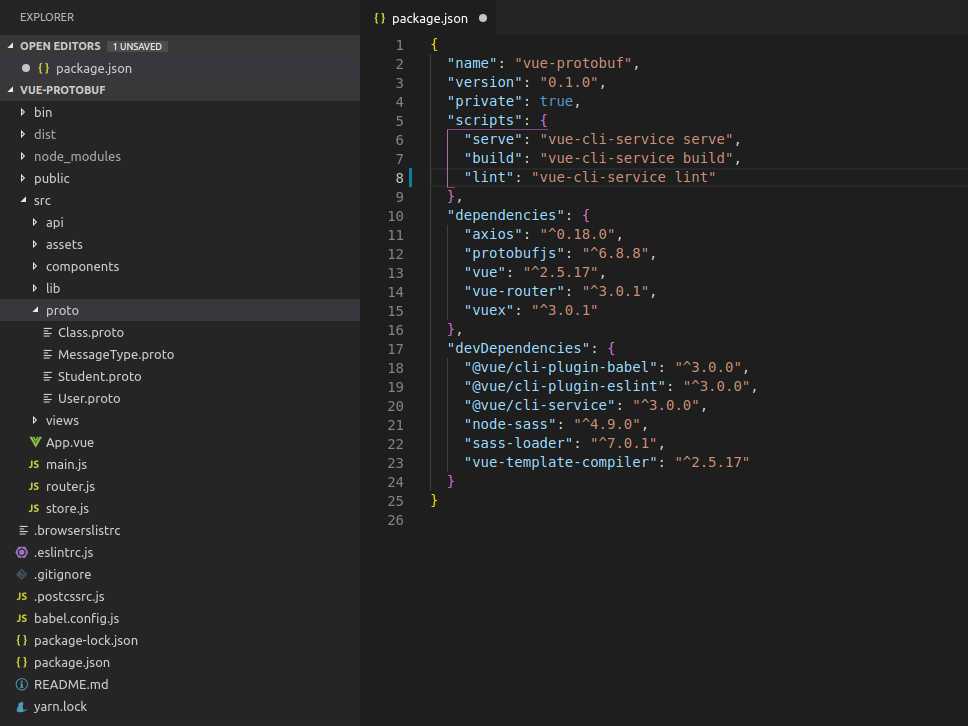标签:工具 pos 解析 values pen package 可扩展 ons 结构
Protobuf是一种轻便高效的结构化数据存储格式,官方定义平台无关、语言无关、可扩展、可用于通讯协议和数据存储等领域。
它有以下优点:
1、平台无关,语言无关,可扩展;
2、他提供了友好的动态库,使用简单;
3、解析速度快。比对应的XML快20-100倍;
4、序列化数据非常简单、紧凑、与XHML相比、他的序列化之后的数据量约为1/3到1/10.
***前后端都可以直接在项目中使用protobuf,不用再特意额外定义model;
***protobuf可以直接作为前后端数据和接口的文档,大大减少了沟通成本;
使用protobuf前后对比:
前=> 后端语言定义的接口和字段,前端是不能直接使用的,前后端沟通是需要一份接口文档的,一旦后端字节有变化,需要修改文档并通知前端,文档更新不及时会造成遗漏加大沟通成本。
后=> protobuf文档是由后端统一定义的,可以直接作为文档,前端只需要将protobuf文件拷贝进前端项目即可,后端字段有改动,只需通知前端更新protobuf文件即可,因为后端是直接使用了protobuf文件,它一般是不会出现遗漏或错误的,这样的话团队合作的效率会增加。
数据传递用json还是protobuf其实对我们开发人员来说没啥大区别,protobuf最后还是要解析成json才能用。
我们公司的项目是基于vue开发的 同样这个也主要是说在vue中使用。
我们要使用protobuf.js这个库来处理proto文件。
protobuf.js提供了几种方法来处理proto。
~ 直接解析,如protobuf.load("awesome.proto",function(err,root) {...}
~ 转化为json或者js后使用,如protobuf.load("awesome.json",function(err,root){...})
~ 其他
.proto文件的存在,因此需要用protobuf.js这个库将*.proto处理成*.js或*.json,然后再利用库提供的方法来解析数据,最后得到数据对象。// /api/student.js 定义接口的文件 import request from ‘@/lib/request‘ // params是object类型的请求参数 // school.PBStudentListReq 是定义好的请求体model // school.PBStudentListRsp 是定义好的响应model // getStudentList 是接口名称 export function getStudentList (params) { const req = request.create(‘school.PBStudentListReq‘, params) return request(‘getStudentList‘, req, ‘school.PBStudentListRsp‘) } // 在HelloWorld.vue中使用 import { getStudentList } from ‘@/api/student‘ export default { name: ‘HelloWorld‘, created () { }, methods: { _getStudentList () { const req = { limit = 20, offset = 0 } getStudentList(req).then((res) => { console.log(res) }).catch((res) => { console.error(res) }) } } }
当拿到一份定义好的proto文件时。(其实我们前端人员不用怎么关心proto文件,这个一般是由后端来定义和维护的,可以直接使用下面定义好的一份demo)
// User.proto package framework; syntax = "proto3"; message PBUser { uint64 user_id = 0; string name = 1; string mobile = 2; } // Class.proto package school; syntax = "proto3"; message PBClass { uint64 classId = 0; string name = 1; } // Student.proto package school; syntax = "proto3"; import "User.proto"; import "Class.proto"; message PBStudent { uint64 studentId = 0; PBUser user = 1; PBClass class = 2; PBStudentDegree degree = 3; } enum PBStudentDegree { PRIMARY = 0; // 小学生 MIDDLE = 1; // 中学生 SENIOR = 2; // 高中生 COLLEGE = 3; // 大学生 } message PBStudentListReq { uint32 offset = 1; uint32 limit = 2; } message PBStudentListRsp { repeated PBStudent list = 1; } // MessageType.proto package framework; syntax = "proto3"; // 公共请求体 message PBMessageRequest { uint32 type = 1; // 消息类型 bytes messageData = 2; // 请求数据 uint64 timestamp = 3; // 客户端时间戳 string version = 4; // api版本号 string token = 14; // 用户登录后服务器返回的 token,用于登录校验 } // 消息响应包 message PBMessageResponse { uint32 type = 3; // 消息类型 bytes messageData = 4; // 返回数据 uint32 resultCode = 6; // 返回的结果码 string resultInfo = 7; // 返回的结果消息提示文本(用于错误提示) } // 所有的接口 enum PBMessageType { // 学生相关 getStudentList = 0; // 获取所有学生的列表, PBStudentListReq => PBStudentListRsp }
可以简单的了解一下proto的语法。在这里有两种命名空间framework和school,PBStudent引用了PBUser,可以认为PBStudent继承了PBUser。
一般来说,前后端需要统一约束一个请求model和响应model,比如请求中那些字段是必须的,返回体中又有那些字段,这里用MessageType.proto的PBMessageRequest来定义请求体所需字段,PBMessageResponse定义为返回体的字段。
PBMessageType 是接口的枚举,后端所有的接口都写在这里,用注释表示具体请求参数和返回参数类型。比如这里只定义了一个接口getStudentList。
拿到后端提供的这份*.proto文件后,是不是已经可以基本了解到:有一个getStudentList的接口,请求参数是PBStudentListReq,返回的参数是PBStudentListRsp。
说白了这个proto文件可以直接作为前后端沟通的文件。
步骤
新建一个vue项目
同时添加安装axios和protobufjs。
# vue create vue-protobuf # npm install axios protobufjs --save-dev
在src目录下新建一个proto目录,用来存放*.proto文件,并将写好的proto文件拷贝进去。
现在的项目目录和package.json:
将*.proto文件生成src/proto/proto.js(***重点)
protobufjs提供了一个叫pbjs的工具,这是一个神器,根据参数不同可以打包成xx.json或xx.js文件。比如我们想打包成json文件,在根目录运行:
npx pbjs -t json src/proto/*.proto > src/proto/proto.json
可以在src/proto目录下生成一个proto.json文件。命令是:
npx pbjs -t json-module -w commonjs -o src/proto/proto.js src/proto/*.proto
-w参数可以指定打包js的包装器,这里用的是commonjs,详情请各位自己去看文档。运行命令后在src/proto目录下生成的proto.js。在chrome中console.log(proto.js)一下
:
这个模块在原型链上定义了load, lookup等非常有用的api,这正是后面我们将会用到的。 为以后方便使用,我们将命令添加到package.json的script中:
"scripts": { "serve": "vue-cli-service serve", "build": "vue-cli-service build", "lint": "vue-cli-service lint", "proto": "pbjs -t json-module -w commonjs -o src/proto/proto.js src/proto/*.proto" },
以后更新proto文件后,只需要npm run proto即可重新生成最新的proto.js。
封装request.js
在前面生成了proto.js文件后,就可以开始封装与后端交互的基础模块了。首先要知道,我们这里是用axios来发起http请求的。
整个流程:开始调用接口 -> request.js将数据变成二进制 -> 前端真正发起请求 -> 后端返回二进制的数据 -> request.js处理二进制数据 -> 获得数据对象。
可以说request.js相当于一个加密解密的中转站。在src/lib目录下添加一个request.js文件,开始开发:
既然我们的接口都是二进制的数据,所以需要设置axios的请求头,使用arraybuffer,如下:
import axios from ‘axios‘ const httpService = axios.create({ timeout: 45000, method: ‘post‘, headers: { ‘X-Requested-With‘: ‘XMLHttpRequest‘, ‘Content-Type‘: ‘application/octet-stream‘ }, responseType: ‘arraybuffer‘ })
MessageType.proto里面定义了与后端约定的接口枚举、请求体、响应体。发起请求前需要将所有的请求转换为二进制,下面是request.js的主函数
import protoRoot from ‘@/proto/proto‘ import protobuf from ‘protobufjs‘ // 请求体message const PBMessageRequest = protoRoot.lookup(‘framework.PBMessageRequest‘) // 响应体的message const PBMessageResponse = protoRoot.lookup(‘framework.PBMessageResponse‘) const apiVersion = ‘1.0.0‘ const token = ‘my_token‘ function getMessageTypeValue(msgType) { const PBMessageType = protoRoot.lookup(‘framework.PBMessageType‘) const ret = PBMessageType.values[msgType] return ret } /** * * @param {*} msgType 接口名称 * @param {*} requestBody 请求体参数 * @param {*} responseType 返回值 */ function request(msgType, requestBody, responseType) { // 得到api的枚举值 const _msgType = getMessageTypeValue(msgType) // 请求需要的数据 const reqData = { timeStamp: new Date().getTime(), type: _msgType, version: apiVersion, messageData: requestBody, token: token } } // 将对象序列化成请求体实例 const req = PBMessageRequest.create(reqData) // 调用axios发起请求 // 这里用到axios的配置项:transformRequest和transformResponse // transformRequest 发起请求时,调用transformRequest方法,目的是将req转换成二进制 // transformResponse 对返回的数据进行处理,目的是将二进制转换成真正的json数据 return httpService.post(‘/api‘, req, { transformRequest, transformResponse: transformResponseFactory(responseType) }).then(({data, status}) => { // 对请求做处理 if (status !== 200) { const err = new Error(‘服务器异常‘) throw err } console.log(data) },(err) => { throw err }) } // 将请求数据encode成二进制,encode是proto.js提供的方法 function transformRequest(data) { return PBMessageRequest.encode(data).finish() } function isArrayBuffer (obj) { return Object.prototype.toString.call(obj) === ‘[object ArrayBuffer]‘ } function transformResponseFactory(responseType) { return function transformResponse(rawResponse) { // 判断response是否是arrayBuffer if (rawResponse == null || !isArrayBuffer(rawResponse)) { return rawResponse } try { const buf = protobuf.util.newBuffer(rawResponse) // decode响应体 const decodedResponse = PBMessageResponse.decode(buf) if (decodedResponse.messageData && responseType) { const model = protoRoot.lookup(responseType) decodedResponse.messageData = model.decode(decodedResponse.messageData) } return decodedResponse } catch (err) { return err } } } // 在request下添加一个方法,方便用于处理请求参数 request.create = function (protoName, obj) { const pbConstruct = protoRoot.lookup(protoName) return pbConstruct.encode(obj).finish() } // 将模块暴露出去 export default request
调用request.js
在.vue文件直接调用api前,我们一般不直接使用request.js来直接发起请求,而是将所有的接口再封装一层,因为直接使用request.js时要指定请求体,响应体等固定的值,多次使用会造成代码冗余。
我们习惯上在项目中将所有后端的接口放在src/api的目录下,如针对student的接口就放在src/api/student.js文件中,方便管理。 将getStudentList的接口写在src/api/student.js中
import request from ‘@/lib/request‘ // params是object类型的请求参数 // school.PBStudentListReq 是定义好的请求体model // school.PBStudentListRsp 是定义好的响应model // getStudentList 是接口名称 export function getStudentList (params) { const req = request.create(‘PBStudentListReq‘, params) return request(‘getStudentList‘, req, ‘school.PBStudentListRsp‘) } // 后面如果再添加接口直接以此类推 export function getStudentById (id) { // const req = ... // return request(...) }
在.vue中使用接口
需要哪个接口,就import哪个接口,返回的是Promise对象,非常方便。<template> <div class="hello"> <button @click="_getStudentList">获取学生列表</button> </div> </template> <script> import { getStudentList } from ‘@/api/student‘ export default { name: ‘HelloWorld‘, methods: { _getStudentList () { const req = { limit: 20, offset: 0 } getStudentList(req).then((res) => { console.log(res) }).catch((res) => { console.error(res) }) } }, created () { } } </script> <style lang="scss"> </style>
总结前端使用的整个流程:
src/proto文件夹npm run proto 生成proto.jssrc/api下写接口.vue文件中使用接口。(其中1和2可以合并在一起写一个自动化的脚本,每次更新只需运行一下这个脚本即可)。
.proto文件的,这时候可以采取protobuf.js提供的其他方法来动态解析proto,不再需要npm run proto这种操作了。标签:工具 pos 解析 values pen package 可扩展 ons 结构
原文地址:https://www.cnblogs.com/jstll/p/10907053.html